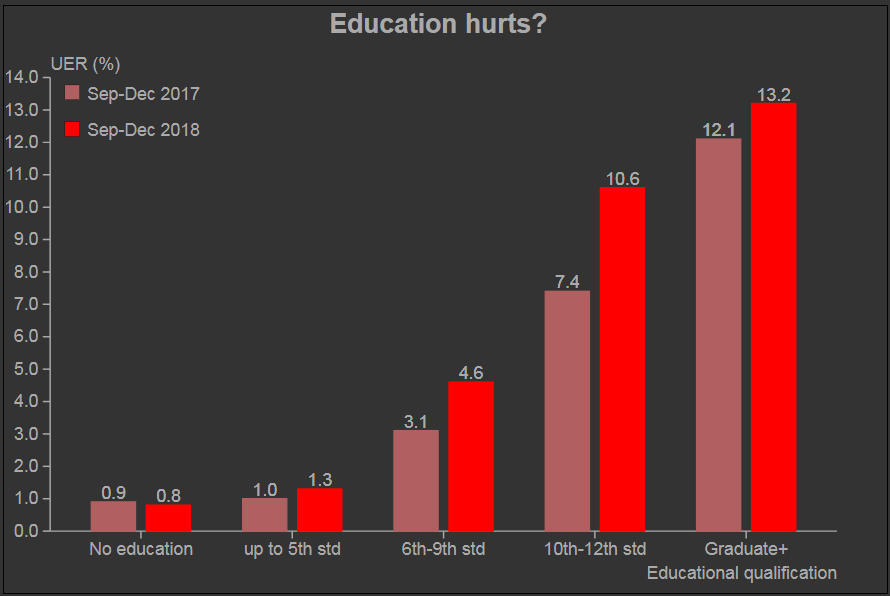 The unemployment rate among those who had completed graduation or higher education (graduate+) has been rising steadily since mid-2017. During September-December 2018, the unemployment rate among these had reached 13.2 per cent. A year ago, the unemployment rate in this group was 12.1 per cent.
The unemployment rate among those who had completed graduation or higher education (graduate+) has been rising steadily since mid-2017. During September-December 2018, the unemployment rate among these had reached 13.2 per cent. A year ago, the unemployment rate in this group was 12.1 per cent.
Graduate+ face the highest unemployment rate among groups of individuals organised by the level of education achieved. It is usually twice the average unemployment rate for the entire labour force. It is worse for graduate+ women.
We consider five groups of individuals by the maximum level of education they obtained – those with no education; those with education upto fifth standard; those with education between sixth and ninth standard; those who cleared tenth, eleventh or twelfth standards; and those who completed graduation or any higher level education than graduation.
During September-December 2018, the average unemployment rate was 6.7 per cent. The uneducated did not face much unemployment as the unemployment rate for them was a negligible 0.8 per cent. These are likely to be the poorer people for whom unemployment is not a choice. They have to take up any job, no matter how poorly paid or however risky. The next group, those with education only up to fifth standard also faced a very small unemployment rate of only 1.3 per cent. The compulsions to take up a job for this group could be no different from the earlier one.
The unemployment rate rises to 4.6 per cent for those who had completed between sixth and ninth standard. For those with qualifications between tenth and twelfth standard, the unemployment rate was uncomfortably high at 10.6 per cent. Then, it rises even higher to 13.2 per cent for graduate+.
This rising of the unemployment rate with rising education levels indicates that India is unable to produce sufficient decent quality jobs for the better educated. And, the better educated are not willing to take up just any crappy job.
The graduate+ section of society is the one that is the most qualified to be employed. But, the higher unemployment rate of these people shows that India does not produce sufficient decent jobs for its graduates. This is the tragedy of India’s employment problem – its higher unemployment for the better educated.
A person with less education has a lesser degree of freedom and so is often compelled to take the available low-paying, low-quality jobs or more often undertake extremely low-quality self-employment. This keeps the unemployment rate in these groups low. But, self-employment is more often a compulsion under distress rather than a choice over a safe job. This is the greater tragedy of India’s employment problem.
CMIE’s Consumer Pyramids Household Survey shows that graduate+ account for only ten per cent of the working age population of India. This is a rather small proportion.
The stock of graduate+ in India was about 100 million during late 2018. Of this, 53 million were employed. Another 8 million were actively looking for a job but were unable to find one. These are the ones we call the unemployed. The remaining 39 million were not sufficiently interested in working. These 39 million are not considered as unemployed. They are voluntarily not in the labour force and therefore are not considered as unemployed.
India has a very low labour participation rate of around 43 per cent. Education in general, and college education in particular is good for labour participation. Labour participation rates are below 40 per cent for those with education below tenth standard. It improves to 43 per cent for those with tenth to twelfth standard education. Then, for the graduate+ group it shoots up to 61 per cent.
Labour participation rate of graduate+ has also improved from less than 60 per cent a year ago to 61 per cent.
College education makes a big difference to women. Overall female labour participation was extremely low at 11.1 per cent during September-December 2018. But the participation was more than twice as high at 22.6 per cent for graduate+ females.
Over the past one year, female labour participation rate fell from 12.1 per cent to 11.1 per cent. But, labour participation among graduate+ women increased from 21.6 per cent to 22.6 per cent. It was stable at 9 per cent for females with an education level between tenth and twelfth standard. But, it declined for women with lower levels of education.
Graduate+ women face a punishing 35 per cent unemployment rate. This is a tragedy of discrimination. The unemployment rate for graduate+ men was much lower at 10 per cent. Why should the few well-educated women who seek jobs face a much higher unemployment rate compared to men with similar education levels?










